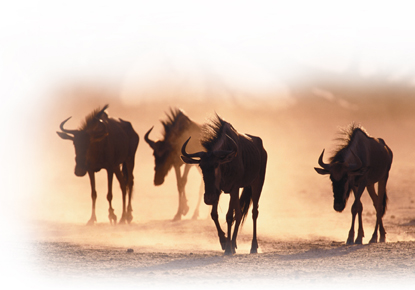28.4 Homeostasis
 Why is the interdependence of body systems essential?
Why is the interdependence of body systems essential? How do animals control their body temperature?
How do animals control their body temperature?
endocrine gland • ectotherm • endotherm
Venn Diagram Draw a Venn diagram comparing and contrasting the temperature control strategies of ectotherms and endotherms.
THINK ABOUT IT A herd of wildebeests plods across Africa's Serengeti Plain. The land is parched, so they are on the move toward greener pastures. They move mechanically, their steps using as little energy as possible. With no food in their guts, their bodies mobilize energy stored in fat deposits for distribution to body tissues. Between drinking holes, their bodies conserve water by producing as little urine as possible. All their body systems work together in a joint effort to survive this difficult passage.
Interrelationship of Body Systems
 Why is the interdependence of body systems essential?
Why is the interdependence of body systems essential?
Homeostasis, or controlled internal conditions, is essential to an organism's survival. Wildebeest brain cells, like those of humans, must be kept at a stable temperature and supplied with a steady stream of glucose for energy—even when the animal is under stress. The brain cells must be bathed in fluid with a constant concentration of water and be cleansed of metabolic waste products. These conditions must not dramatically change during droughts, floods, famines, heat, or cold. Failure of homeostasis, even for a few minutes, would lead to permanent brain injury or death.
You've learned about digestive, respiratory, circulatory, excretory, nervous, muscular, and skeletal systems separately. Yet all of these systems are interconnected.  All body systems work together to maintain homeostasis. In most animals, respiratory and digestive systems would be useless without circulatory systems to distribute oxygen and nutrients. Similarly, the excretory system needs a circulatory system to collect carbon dioxide and nitrogenous wastes from body tissues and deliver them to the lungs and excretory organs. Muscles wouldn't work without a nervous system to direct them and a skeletal system to support them.
All body systems work together to maintain homeostasis. In most animals, respiratory and digestive systems would be useless without circulatory systems to distribute oxygen and nutrients. Similarly, the excretory system needs a circulatory system to collect carbon dioxide and nitrogenous wastes from body tissues and deliver them to the lungs and excretory organs. Muscles wouldn't work without a nervous system to direct them and a skeletal system to support them.
In addition to the organ systems that you have already learned about, you will now learn about other body systems, those that fight disease, produce and release chemical controls, and manage body temperature—all to help ensure homeostasis.

FIGURE 28–26 Interrelationship of Body Systems All body systems must work together to keep stressed animals, such as these migrating wildebeests, alive.

Table of Contents
- Formulas and Equations
- Applying Formulas and Equations
- Mean, Median, and Mode
- Estimation
- Using Measurements in Calculations
- Effects of Measurement Errors
- Accuracy
- Precision
- Comparing Accuracy and Precision
- Significant Figures
- Calculating With Significant Figures
- Scientific Notation
- Calculating With Scientific Notation
- Dimensional Analysis
- Applying Dimensional Analysis




